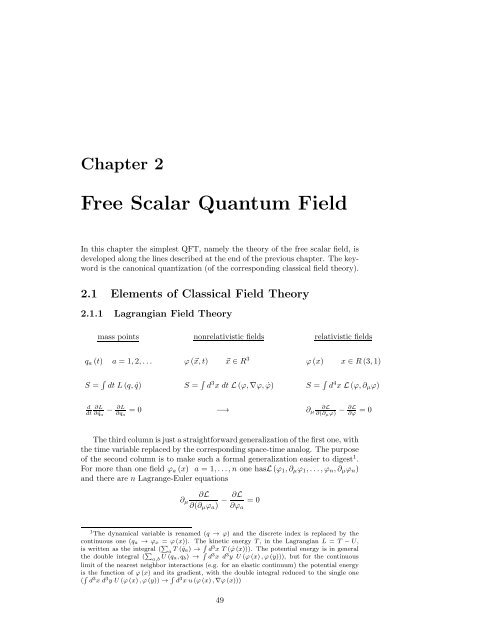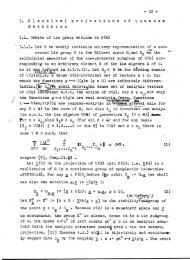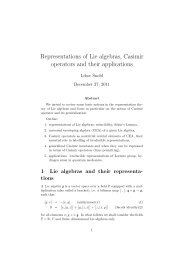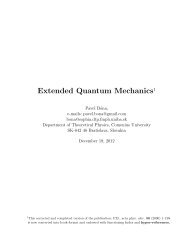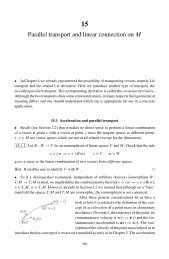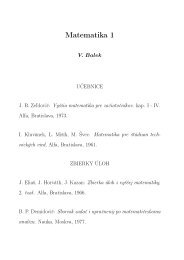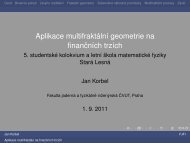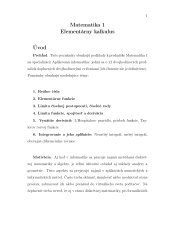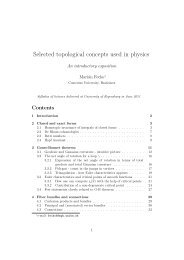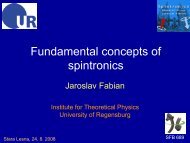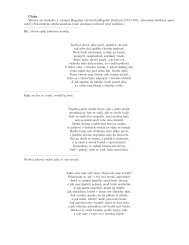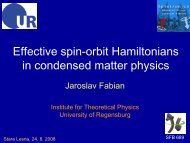Quantum Field Theory I
Quantum Field Theory I
Quantum Field Theory I
You also want an ePaper? Increase the reach of your titles
YUMPU automatically turns print PDFs into web optimized ePapers that Google loves.
Chapter 2<br />
Free Scalar <strong>Quantum</strong> <strong>Field</strong><br />
In this chapter the simplest QFT, namely the theory of the free scalar field, is<br />
developed along the lines described at the end of the previous chapter. The keyword<br />
is the canonical quantization (of the corresponding classical field theory).<br />
2.1 Elements of Classical <strong>Field</strong> <strong>Theory</strong><br />
2.1.1 Lagrangian <strong>Field</strong> <strong>Theory</strong><br />
mass points nonrelativistic fields relativistic fields<br />
q a (t) a = 1,2,... ϕ(⃗x,t) ⃗x ∈ R 3 ϕ(x) x ∈ R(3,1)<br />
S = ∫ dt L(q, ˙q) S = ∫ d 3 x dt L(ϕ,∇ϕ, ˙ϕ) S = ∫ d 4 x L(ϕ,∂ µ ϕ)<br />
d ∂L<br />
dt ∂ ˙q a<br />
− ∂L<br />
∂q a<br />
= 0 −→ ∂ µ<br />
∂L<br />
∂(∂ µϕ) − ∂L<br />
∂ϕ = 0<br />
Thethirdcolumnisjustastraightforwardgeneralizationofthefirstone,with<br />
the time variablereplacedby the correspondingspace-timeanalog. The purpose<br />
of the second column is to make such a formal generalization easier to digest 1 .<br />
For more than one field ϕ a (x) a = 1,...,n one hasL(ϕ 1 ,∂ µ ϕ 1 ,...,ϕ n ,∂ µ ϕ n )<br />
and there are n Lagrange-Euler equations<br />
∂ µ<br />
∂L<br />
∂(∂ µ ϕ a ) − ∂L = 0<br />
∂ϕ a<br />
1 The dynamical variable is renamed (q → ϕ) and the discrete index is replaced by the<br />
continuous one (q a → ϕ x = ϕ(x)). The kinetic energy T, in the Lagrangian L = T − U,<br />
is written as the integral ( ∑ a T (˙qa) → ∫ d 3 x T ( ˙ϕ(x))). The potential energy is in general<br />
the double integral ( ∑ a,b U (qa,q b) → ∫ d 3 x d 3 y U (ϕ(x),ϕ(y))), but for the continuous<br />
limit of the nearest neighbor interactions (e.g. for an elastic continuum) the potential energy<br />
is the function of ϕ(x) and its gradient, with the double integral reduced to the single one<br />
( ∫ d 3 x d 3 y U (ϕ(x),ϕ(y)) → ∫ d 3 x u(ϕ(x),∇ϕ(x)))<br />
49


